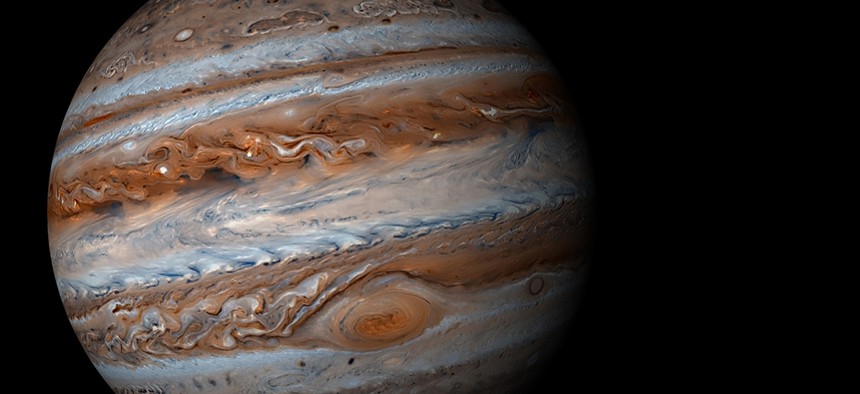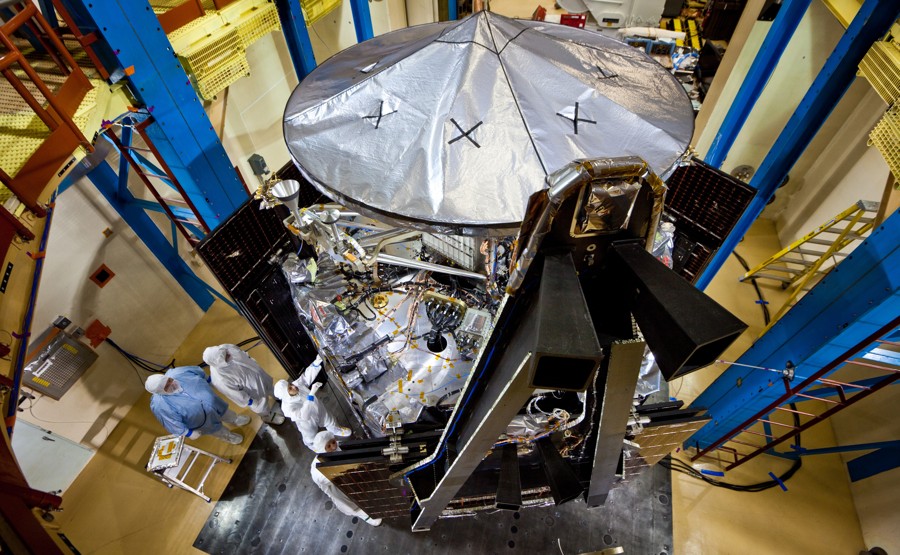Sending an Armored Tank to Outer Space

Ksanawo/Shutterstock.com
The spacecraft Juno was designed to make it all the way to Jupiter, then orbit the planet without getting destroyed in the process
Jupiter is not to be trifled with.
The gargantuan planet is a gas giant, a term that makes it sound far gentler than it actually is. In fact, Jupiter is severe and volatile.
Its famous Great Red Spot is a violent anticyclone three times the size of Earth that has been raging for at least 400 years. The radiation around Jupiter is a menace, 1 million times more intense than radiation belts that surround Earth. The Jovian magnetosphere, which powers its radiation belts and produces brilliant permanent auroras around the planet’s poles, is the largest structure in our solar system.
“Northern Lights on steroids,” as Randy Gladstone, a planetary scientist who focuses on airglow, once put it to NASA. “They're hundreds of times more energetic than auroras on Earth.”
Destination: Jupiter "Magnetic Field" from CuriosityStream on Vimeo.
So, yeah, you don’t want to mess with Jupiter.
Except that scientists do want to mess with it, or at least get close enough to take a few spins around the planet, capture some gorgeous photos and gather enough data to determine how the planet formed in the first place. Figuring out Jupiter’s origin story is one of the keys to understanding the rest of the solar system. It’s also a central goal of the Juno mission, which reaches a critical phase next week.
In the five years since the probe launched, Juno has reached a distance of some 500 million miles (500 million miles!) from Earth. On July 4, it will attempt to complete a sophisticated maneuver called an orbital insertion—a move that, if successful, will put Juno in Jupiter’s orbit, and allow humankind to get closer to the planet than ever before.
Building a spacecraft capable of accomplishing all this is basically like designing an armored tank for outer space. Only it’s a 3,500-pound solar powered, spin-stabilized tank that travels faster than any manmade object in history—some 165,000 miles per hour, a speed that could take it around the Earth in 10 minutes flat, according to Destination: Jupiter, a documentary about the mission that was released June 24.
The maneuver on July 4 represents a crucial milestone for a spacecraft that began to take shape 13 years ago, when a group of scientists at Lockheed Martin started brainstorming what they would need to build by listing the biggest challenges Juno would face.
“It’s a long ways away, so it’s pretty dark out there,” said Kevin Rudolph, an engineer at Lockheed Martin, which designed and built Juno. “It’s cold because it’s dark. It’s a vacuum. And it doesn’t have any gravity. These are the usual things you think of when you think about space travel.”
But sending a spacecraft to Jupiter comes with its own set of unique challenges. Radiation is one of the big ones.
“If you were sitting outside of this vault on our spacecraft, by the end of the mission, you would have gotten the equivalent of about 100 million dental X-Rays—which would be like sitting in a dentist’s chair getting an X-Ray once a second, every second, for a bit over three years,” said Tracy Drain, a systems engineer at the Jet Propulsion Laboratory, in Destination: Jupiter.
This sort of exposure would easily fry electronic systems. To protect them, you can either shield those systems, or design electronics that might withstand radiation.
“We did that as much as we could, but [designing durable systems] was not in and of itself enough to provide us the kind of radiation capability that we needed to have for Jupiter,” Rudolph told me. “So. we also went back and looked at how to protect the electronics.”
One strategy would have been to put a small shield around every device, but to keep the probe’s mass down, it made more sense to put one big shield around a cluster of electronics.
“Essentially, we built a vault,” Rudolph said. They put all the electronics inside a cube that measures 1 meter on all sides—a cube that’s also plated with half-an-inch of titanium. “We still end up accumulating some dose of radiation,” Rudolph said. “But it’s about 1,000 times smaller a dose than if the spacecraft avionics were just sitting out in open space.”
The thing is, you can’t just cover everything in titanium. To take photos, for instance, a camera has to be able to see outside of the craft without a titanium shield blocking its view. Same goes for the solar panels that helped Juno break the record for humanity’s most distant solar-powered emissary. (The probe made history back in January when it crossed the 493-million-miles-away-from-the-sun threshold.)
Juno’s cameras are protected by conical shields—basically megaphone-shaped devices that extend out from the lens.
“You can still imagine that if a really insidious and very smart particle was traveling right straight down the cone, it could hit the lens,” Rudolph said. “But we’ve evaluated that and convinced ourselves that the probability is very low.”
There were other considerations to be made about the probe’s durability. Along with being able to withstand brutal radiation bombardment and frigid temperatures, Juno has Jupiter’s astonishing magnetosphere to contend with—the biggest threat from which is electricity.
“The spacecraft has a whole lot of metal on it,” Rudolph said. “It’s moving at a huge velocity through Jupiter’s magnetic field, so it generates electricity. If you’re not careful that electricity can build up to high voltages and you can start getting little arcs and sparks, kind of like when you shuffle your feet across the carpet and zap your finger on a doorknob. Computers don’t like little arcs and sparks.”
To prevent those little arcs and sparks, Juno’s designers made sure all the metal components were connected in some way, then wrapped in multilayer insulation. Then they covered that insulation with a thin metal layer so that the whole spacecraft was pretty much covered.
“So, if there’s a charge buildup in one place, it basically flows throughout the entire spacecraft evenly," Rudolph said. "And that’s OK. If everything’s even, you don’t have any piles of electrons in one place, arcing to a place where there aren’t any.”
But then, there are the rocks.
“The rocks that people tend to imagine, like pebbles, are so utterly rare that the chances of getting hit with something even as big as a pea is just so remote it’s not worth worrying about,” Rudolph told me. “In fact, we don’t. But there are rocks out there that are, say, a millimeter in diameter or smaller.”
There are lots of these micron-sized rocks, in fact, but Juno’s multilayer insulation is designed so that the probe can power through them without being damaged. Rudolph compares the layers of this sheeting to a bullet proof vest, though the insulation looks mostly like Duct tape—a dull silver color.
If a particle dents the first layer, it’s unlikely to affect the second layer. And even if it has enough energy to get through the second layer, there are third and fourth layers to protect the guts of the spacecraft. If you were to touch these outer layers, they’d feel malleable—like a shower curtain or Mylar balloon, Rudolph says.

If something unforeseen goes wrong, there’s also a restart button. So, if an anomaly in Jupiter’s environment causes the computer to reset, instead of making it idle in safe mode, engineers have the option to cycle through to a restart so it can still function properly. (They can do this more than once if they have to.)
“An interruption, we think, is unlikely,” said Rick Nybakken, a project manager for Juno. “But of course, we have to plan for the unlikely events.”
That kind of planning meant seven years of designing, building and testing—a process that combined computer modeling, lab work, and environmental simulations featuring extreme cold and heavy doses of radiation. Finally, in 2011, Juno launched. And in one week, the probe will face its biggest test since that day.
The orbital maneuver, which will begin based on a sequence of preprogrammed commands, is “the really big moment,” said Scott Bolton, Juno’s principal investigator. “That’s the highest risk left in the mission, getting into orbit in Jupiter. A lot of things can go wrong.”
The maneuver itself involves firing Juno’s main engine at just the right time and in just the right direction so that the spacecraft slows down enough to enter Jupiter’s orbit safely, using Jupiter’s gravity for leverage—rather than spinning off into space.
“We’re going really close, closer than any spaceship has gone before, and humans can’t really intervene once [the maneuver begins],” Bolton said. “It all has to happen automatically, or it doesn’t work. This is all or nothing. You either get into orbit or not.”
If Juno successfully enters Jupiter’s orbit, it will still be approximately two months before the first major trove of data is transmitted back to Earth.
“It’s a critical milestone,” Nybakken said of the orbital maneuver. “But you could also think of it as a a gateway to the science mission. And the science mission itself is very exciting.”
Planetary scientists expect to get remarkable photos of Jupiter and its auroras, for example. Even before the orbit insertion, they’ll capture footage of the Galilean moons circling the planet. (“It will be the first time humanity’s been able to see one celestial object go around another,” Bolton told me.) They also hope Juno may be able to tell them what the planet’s core is made of, and the extent of Jupiter’s global water abundance.
“That one number, the amount of water, tells us a huge amount about how Jupiter formed,” Steven Levin, a project scientist for Juno, told me. “Knowing how Jupiter formed tells us how the other planets in the solar system formed, which helps us begin to understand the answers to [questions like], ‘Where did we come from?’ and ‘How did we get here?’”
NEXT STORY: Video: Why Did NASA Set a Fire in Space?





